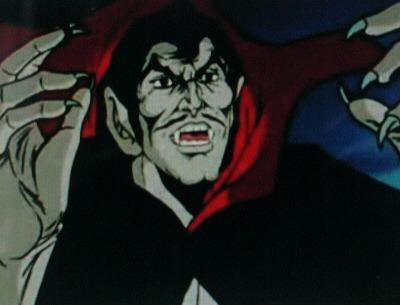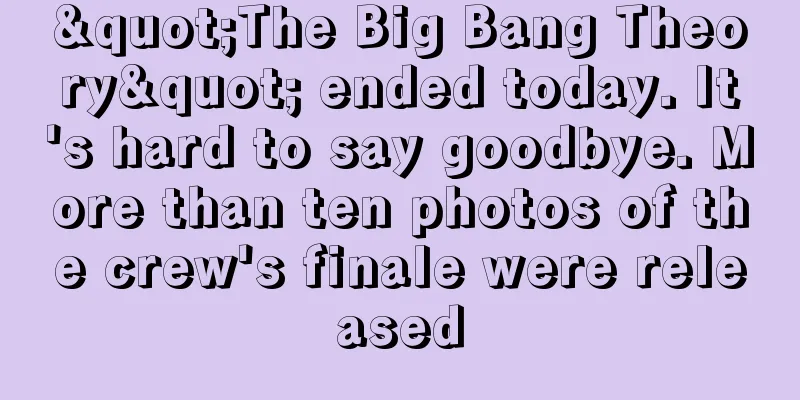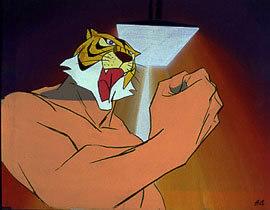Review of Dracula: The Dark Lord - The Deepest Terror and Charm

The Dark Lord, the Vampire Dracula - A Tale of the Deep and Its Appeal■ Public MediaTV Special ■ Original Mediacomics ■ Broadcast periodAugust 19, 1980 - January 1, 0000 ■Broadcasting stationANB ■Frequencies94th minute ■ Number of EpisodesEpisode 1 ■Original StoryMinoru Okazaki, Marvel Comics "The Tomb of Dracula" (Creative Consultant Gene Pelk) (Reference: "The Devil's Book" translated by Hikari Hinatsu (Tairiku Shobo Publishing)) ■ Director・Direction: Minoru Okazaki ■ Production・Production: ANB, Toei (animation) ■ StoryWhen a "Black Mass" was being held in a church in Boston, Dracula suddenly bursts in and kidnaps Domini, a young girl who was to be sacrificed to the devil. Dracula takes Domini back to his hideout and tries to suck her blood, but he is unable to do so because he has fallen in love with her. Dracula's human heart is restored and he marries Domini and gives birth to a boy, Jenas. Lupesky, a priest at the Black Mass, is angry that Domini has married Dracula and attacks the couple. However, Lupesky's bullet hits the young Jenas' chest and he dies. Dracula, who lost his son, is furious and returns to his violent nature, attacking the people of Boston every night. Quincy, an old man whose father was once killed by Dracula, forms a group of vampire hunters with Frank, a martial arts master, and Rachel, a crossbow user, and is burning with revenge. Meanwhile, when Domini was grieving over Jenas's grave and was about to take his own life, a miracle occurred. In a golden light, the coffin rose into the sky, and a noble young man descended from the heavens and merged with Jenas. Jenas returned to life as an adult. However, Jenas had been given the mission by God to defeat Dracula. Domini shed tears at this ironic fate, but was powerless to stop the father-son showdown between Dracula and Jenas. A fierce battle unfolds, involving the efforts of the Emperor of Darkness, Jenas the messenger of God, a vampire hunter who hates Dracula, Dracula's daughter Lilas, and Satan the Great of Hell... ■Cast・Dracula/Kenji Utsumi・Domini/Hiroko Suzuki・Jenus/Kazuyuki Sogabe・Quincy/Yasuo Hisamatsu・Rachel/Mami Koyama・Frank/Keiichi Noda・King Satan/Hidekatsu Shibata・Lilas/Reiko Katsura・Lupeski/Junpei Takiguchi・Narrator/Ryo Ishihara・Young A/Kazuyuki Sogabe・Master/Hidekatsu Shibata・Silver/Reiko Katsura・Wheeler, Young C/Koji Toya・Boyfriend, Young B/Masaharu Sato・Carly, Maisa, Woman A/Seiko Nakano・Anton, Woman B/Satomi Mashima・Togo, Announcer/Yasuhiro Tanaka ■ Main staff・Planning: Yoshiaki Koizumi (TV Asahi), Yoshifumi Hatano, Takeyuki Suzuki ・Original story: Marvel Comics "The Tomb of Dracula" ■ Background and production secrets of the work"Dracula: The Dark Lord" is a TV special that aired on TV Asahi in 1980 and is based on the Marvel Comics book "The Tomb of Dracula." This work is a reinterpretation of the story of the vampire Dracula in the form of Japanese animation, and it made a strong impression on audiences at the time. In particular, the process of Dracula regaining his humanity, his bond with his family, and his final tragic ending deeply touched the hearts of viewers. The background to the production was heavily influenced by the trends in the animation industry at the time and the needs of viewers. In the early 1980s, works incorporating horror elements were popular, and the vampire theme was perfect for attracting viewers' interest. In addition, the fact that the original work was a famous overseas work, Marvel Comics, also contributed to increasing the topic of discussion. As for behind-the-scenes stories, director Minoru Okazaki faithfully recreated the worldview of the original work while also making efforts to make it acceptable to Japanese anime fans. In particular, the meticulous drawings by Hiroshi Wagatsuma, who was in charge of character design and animation direction, created a strong visual impact and enhanced the appeal of the work. Additionally, the classical melodies by Seiji Yokoyama, who was in charge of the music, played a role in further enhancing the atmosphere of the story. ■Character AnalysisDraculaDracula is the central character of this work, and is a being who combines the terrifying power of a vampire with the fragility of a human being. Kenji Utsumi's voice acting realistically expressed Dracula's complex emotions, leaving a deep impression on the audience. In particular, his love for Domini and his anger over the death of Jenas strongly convey Dracula's humanity. DominiDomini is Dracula's beloved woman and a key character in the story. Hiroko Suzuki's voice acting expresses Domini's purity and strength, evoking sympathy from viewers. Her presence plays an important role in bringing out Dracula's humanity. JenasJenas is the son of Dracula and Domini, and a character who carries a mission from God. Kazuyuki Sogabe's voice acting portrayed Jenas' growth and struggles realistically, deeply moving viewers. In particular, the confrontation scene with his father, Dracula, is a memorable scene that touches the hearts of viewers. QuincyQuincy is an old man whose father was killed by Dracula, and is the leader of the vampire hunters. Yasuo Hisamatsu's voice acting realistically portrayed Quincy's desire for revenge and sense of justice, leaving a strong impression on viewers. His presence plays an important role in increasing the tension of the story. RachelRachel is a crossbow user and a member of the Vampire Hunters. Mami Koyama's voice acting portrayed Rachel's bravery and determination in a realistic way, resonating with viewers. Her presence symbolizes the teamwork of the Vampire Hunters. FrankFrank is a martial artist and a member of the Vampire Hunters. Keiichi Noda's voice acting portrayed Frank's strength and calmness in a realistic way, leaving a strong impression on viewers. His presence enhances the strategic nature of the Vampire Hunters. Satan the GreatKing Satan is the ruler of Hell and the enemy of Dracula. Hidekatsu Shibata's voice acting realistically portrayed the terror and majesty of King Satan, leaving a strong impact on the audience. His presence plays an important role in enhancing the scale of the story. LyrathLylas is Dracula's daughter and an important character in the story. Reiko Katsura's voice acting portrayed Lylas's complex emotions realistically, leaving a deep impression on the audience. Her presence brings out the family side of Dracula. ■Story development and themeThe story of "Dracula" begins with the scene where Dracula kidnaps Domini. This scene draws the viewer's interest by contrasting Dracula's horror with Domini's purity. As the story progresses, the process of Dracula falling in love with Domini and regaining his humanity is depicted. This part makes the viewer feel Dracula's humanity and evokes sympathy. However, the scene where the black mass priest Lupeski attacks Dracula and Domini and Jenas dies is a turning point in the story. This scene marks the beginning of Dracula's collapse of humanity and his return to his violent nature. Jenas' death also heightens the grief of Domini and the anger of Dracula, increasing the tension of the story. The scene where Jenas miraculously comes back to life and takes on God's mission is an important point leading up to the climax of the story. This scene symbolizes Jenas' growth and his confrontation with Dracula, and deeply moves the viewer. Ultimately, the story concludes with a tragic ending as the father-son confrontation between Dracula and Jenas unfolds. This ending leaves the viewer with deep emotions and lingering impressions. The themes of this work are love, revenge, and the conflict of humanity. The process in which Dracula falls in love with Domini and regains his humanity illustrates the power of love and its fragility. Meanwhile, the death of Jenas and Dracula's return to his violent nature illustrate the horror of revenge and its consequences. Furthermore, the scene in which Jenas, carrying out his mission from God, confronts Dracula symbolizes the conflict of humanity and its consequences. These themes provide viewers with deep emotions and elements that make them think. ■ The appeal of video and musicThe visuals of "Dracula: The Dark Lord" are characterized by the character designs of Hiroshi Wagatsuma and the detailed drawings of the animation director. In particular, the scenes expressing the horror and humanity of Dracula, and the scene where Jenas miraculously returns to life, leave a strong visual impact. In addition, the beautiful depictions of the background art by Hidenobu Hata further enhance the atmosphere of the story. The music is characterized by classical melodies by Seiji Yokoyama. In particular, the music enhances the atmosphere of the story in the scenes where Dracula regains his humanity and where Jenas dies and Dracula returns to his violent nature. The performance by the Transylvanian Baroque Ensemble also plays an important role in enhancing the scale of the story. ■ Viewer reactions and ratings"Dracula: The Dark Lord" was a TV special that was broadcast in 1980 and was highly praised by viewers. In particular, the story that depicted Dracula's humanity and the conflict he faced deeply moved viewers. In addition, Hiroshi Wagatsuma's meticulous drawings and Seiji Yokoyama's classical music also captured the hearts of viewers. Many viewers sympathized with Dracula's humanity and the conflict he faced. The miraculous return to life of Jenas and the confrontation between Dracula and Jenas as father and son also left a strong impression on viewers. Furthermore, the character designs by Hiroshi Wagatsuma, the detailed drawings by the animation director, and the classical music by Seiji Yokoyama also contributed to the high evaluation of the film by viewers. ■ Recommendations and related works"Dracula: The Dark Lord" is a work that depicts the story of the vampire Dracula, and is a work that combines horror elements and human drama. To enjoy this work, it is recommended for those who are interested in horror elements and human drama. It is also recommended for those who are interested in the story of the vampire Dracula. Related works include "The Tomb of Dracula" by Marvel Comics and other vampire-themed works. In particular, "The Tomb of Dracula" by Marvel Comics is the original work of this work, and it is recommended to read it to gain a deeper understanding of the story of the vampire Dracula. In addition, other vampire-themed works can also be a reference for enjoying the story of the vampire Dracula. Conclusion"Dracula: The Dark Lord" is a work that depicts the story of the vampire Dracula, and combines horror elements with human drama. The story that depicts Dracula's humanity and its conflicts, the detailed drawings by Hiroshi Wagatsuma, and the classical music by Seiji Yokoyama deeply moved viewers. This work is recommended for those who are interested in horror elements and human drama, and those who are interested in the story of the vampire Dracula. You can also enjoy related works such as Marvel Comics' "Tomb of Dracula" and other vampire-themed works. |
<<: The appeal and reviews of "Fumoon": Why you shouldn't miss it
>>: Review of "Legend of Marine Snow": A mysterious and moving story of the sea
Recommend
Sunrise's new mecha show "Boundary Fighter" Season 2 confirmed to be officially launched in April
The first season of "Fighter" a new mec...
18 years later, the touching return! "Spirited Away" is scheduled to be released in China on June 21st, and the tear-jerking trailer is released
According to the latest report from the official ...
The 20th anniversary movie version of "Digimon" is confirmed to be imported? Just bought the copyright
Recently, there have been rumors online that the ...
Official trailer for Season 2 of Invincible Youngsters released
The first four episodes of the second season of t...
The appeal and reviews of "Aishiteruze Baby★★": A must-see anime experience
"I Love You Baby★★": A story of family ...
The third season of the TV animation "Kingdom" is confirmed to be released in April 21, and a new trailer has been released
In April this year, the official announced that d...
Ellie's actress thinks The Last of Us could have a second season
HBO's The Last of Us series had a good start,...
Sigourney Weaver and Bill Murray to Return for Ghostbusters Movie
Sigourney Weaver has confirmed that she will repr...
"Oyama no Taisho" review: Exploring the depth of the story and characters
"Oyama no Taisho" - A masterpiece of pr...
The appeal and reviews of Kirakira☆PreCure A La Mode: A new spark for the PreCure series
The appeal and reviews of Kirakira PreCure A La M...
Review of "Secret Society Eagle Talon Gaiden Secret Stables Horse Hoof": A spin-off work full of laughs and surprises
Secret Society Eagle Talon Gaiden Secret Stable H...
Magical Girl Special Ops Asuka: A deep look into the fascinating story and characters
Magical Girl Special Ops Asuka - A Story of Profo...
Marvel Animated Series "What If" Releases New Trailer British Female Captain is Coming
The Marvel animated series "What If" re...
A thorough look at the charm and emotion of "The Zebra and the Lion"! What is the secret behind this beloved classic?
Zebra and Lion - Zebra and Lion overview "Th...
Secret Anima LOVE2Police: A Must-See Anime Guide
Secret Anima LOVE2Police - Secret Anima Love Love...









